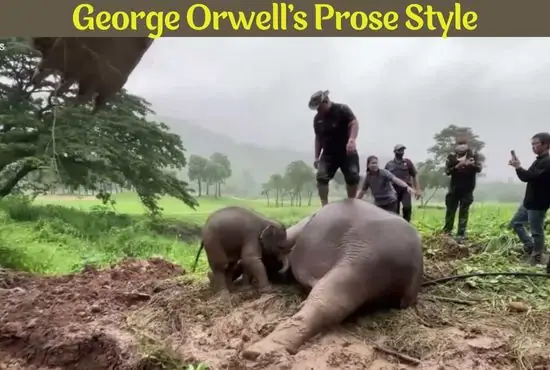Prose Style of George Orwell in Shooting an Elephant
“Good prose” asserts George Orwell in one of his characteristically vivid similes, “is like a window pane.” A window pane allows a clear view through it so long as one constantly keeps it clean and takes care that no dust or soot settles on its surface. In a similar way, good prose is expected to give the reader a clear idea or a vivid image of what is being stated or described. But, in order to write such prose, the writer must spare no pains to keep his language clear, lucid and precise. In short he must be a conscious artist who chooses his words and expressions carefully and never lapses into banalities. In all his writings, Orwell tried his best to live up to this high ideal of a good writer of prose. He is a meticulous artist whose concern for the ‘right expression’ frequently borders on fastidiousness.
The essay Shooting an Elephant, with its vivid representation of a tense situation, reads very much like an absorbing running commentary. The compelling effect of his conscious artistry can be clearly seen in the living description of how he shot the elephant and how the animal gradually sank to the ground.
In Shooting an Elephant, as in many others of his essays, we come across a wealth of detail which is the fruit of a meticulously careful observation. This was bound to be so. For, Orwell scarcely allowed himself to stray beyond his first-hand experience. To description of the locality where the Burmese sub-inspector was waiting for him is a case in point.
Also Read:
His narrative technique is all his own. His manner of narration makes the reader visualize the incident he is narrating. While reading Shooting an Elephant, we can see before our eyes ‘the sea of yellow faces’ eagerly watching the author as they would watch ‘a conjurer about to perform his trick’. And, after the third shot had been fired, we can see the collapsing elephant towering upwards ‘like a huge rock toppling’. But his narration of the incident is now and then punctuated with authorial comments which introduces an element of drama into the narrative. Thus the narrative in Shooting an Elephant is enlivened with an inner drama of absorbing psychological interest. This drama starts from the moment when the author realises that he would have to shoot the elephant much against his will. And this drama culminates in the strikingly pithy observation that the white man’s life in the East is ‘one long struggle not to be laughed at’.
This essay does not give us a taste of Orwell’s sharp and biting satire which sometimes reminds the reader of Jonathan Swift. But a broad sense of humour pervades, the whole essay. And, much like’ Lamb, Orwell can laugh even at his own cost. In this essay, he does not hesitate to picture himself as ‘an absurd puppet’ driven by the will of a huge crowd of natives.
Orwell’s language is neat, lucid, racy and graceful. He had an uncanny knack for pithy remarks packed with meaning. His famous remark in Animal Farm found its way into The Oxford Dictionary of Quotations: “All animals are equal but some animals are more equal than others.” In Shooting an Elephant, we come across quite a few such remarks. Speaking of the dilemma of the white man in the East, he observes:
“He wears a mask, and his face grows to fit it.”
His similes sometimes make a situation more clearly visible than a whole page of narration might do. Considering the eventuality of the elephant charging at him, he says that he would then have as much a chance as a toad under a steam roller’.
All these stylistic features, taken together, easily makes Orwell one of the best “writers of English prose. Though it is chiefly his novels that have earned a permanent place in English literature, his style, with its strongly individual flavour, appears particularly suitable for the kind of personal essay of which Shooting an Elephant remains a typical and admirable example.

Hello, Viewers! Besides being the Founder and Owner of this website, I am a Government Officer. As a hardcore literary lover, I am pursuing my dream by writing notes and articles related to Literature. Drop me a line anytime, whether it’s about any queries or demands or just to share your well-being. I’d love to hear from you. Thanks for stopping by!
